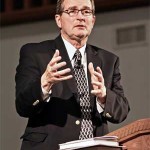 The Marrow of Calvinism by Joel Beeke
The Marrow of Calvinism by Joel Beeke
‘There is no true religion in the world which is not Calvinistic-Calvinistic in its essence, Calvinistic in its implications…. In proportion as we are religious, in that proportion, then, are we Calvinistic; and when religion comes fully to its rights in our thinking, and feeling, and doing, then shall we be truly Calvinistic…. [Calvinism] is not merely the hope of true religion in the world: it is true religion in the world-as far as true religion is in the world at all.’ – BENJAMIN B. WARFIELD
If you were to ask theologians in seminaries or people on the street, “What is Calvinism all about?” the answers you would receive would vary widely. Caricatures abound. For instance, on Thanksgiving Day 2007, the Grand Rapids Press printed an article by John M. Crisp titled, “Thinking like a Pilgrim on Thanksgiving.” It said of the Pilgrims: “Their religious roots reached back to the gloomy tenets of John Calvin, which means-at the risk of oversimplificationthat they lived with the nagging fear that they dangled every moment by a thin thread over the fiery pit of hell in spite of their own faith or good works or the outward manifestations of the blessings of God.”2
Does any Calvinist recognize this as a definition of Calvinism? I wrote back to the Grand Rapids Press: “This statement is not an oversimplification. It is a misrepresentation. Calvin and most of the Pilgrims rejoiced in Christ their Savior, and lived joyous Christian lives of spiritual depth with assured faith in the rich promises of God.”3
Of course, most evangelical Christians and, sadly, even some Calvinists, lack a proper understanding of the real heartbeat of Calvinism. “There is nothing upon which men need to be more instructed than upon the question of what Calvinism really is,” Charles H. Spurgeon once said.4 Whether you are a Calvinist, a non-Calvinist, or an anti-Calvinist, you need to give this question a fair hearing: what really is the marrow of Calvinism?
THE BASIC PRINCIPLE OF CALVINISM
Calvinistic theology includes all the essential evangelical doctrines, such as the deity of Christ, objective atonement, and the person and work of the Holy Spirit. It also includes many doctrines developed by theological giants such as Athanasius, Augustine, Anselm, and Martin Luther. Yet, it is not entirely correct to say, as did “Rabbi” John Duncan, “There’s no such thing as Calvinism [because] the teachings of Augustine, Remigius, Anselm, and Luther were just pieced together by one remarkable man [Calvin], and the result baptized with his name.”‘
Calvin’s synthesis is far more remarkable than that; he certainly was no midget standing on Augustine’s giant shoulders. Calvin’s presentation of the plan of salvation, choice of materials, and sense of the interconnectedness of biblical doctrine are unique. He was a genius in organization and systematization. His indebtedness to his predecessors does not detract from his originality, which is clearly evident in his doctrine of divine Sonship; his emphasis on the humanity of the Redeemer and His threefold mediatorial office as Prophet, Priest, and King; his explanation of the inward witness of the Holy Spirit; his development of Presbyterian church polity; and his exposition of how worship should be based on the Second Commandment, which the Puritans would later develop as the regulative principle of worship.
In addition, Calvinists throughout history have not been mere imitators of Calvin. For example, in their development of covenant theology, decretal theology, and the doctrine of assurance of faith, they labored hard to explain the whole counsel of God within the context of all the profundity, harmony, and consistency of Scripture. Continue reading

